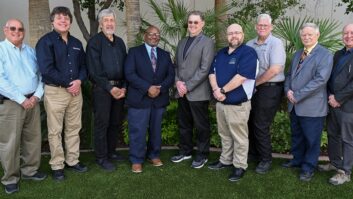
WDAV’s antenna nears completion. The last section is hoisted up.
DAVIDSON, N.C. — Our phone has rung many times with word that lightning has struck an FM antenna. In this case, one of Schropp Electronics Services’ long-term customers, WDAV(FM), in Davidson, N.C., had the problem. The symptom was the always-unwelcome high VSWR alarm that had shut down the transmitter.
Jim Schropp, my son and an engineer for Schropp Electronics Services, was first to respond. He checked to see if the fault would clear, rechecked for VSWR and ran the transmitter into the dummy load. It became apparent that the antenna system was the problem. Fortunately, WDAV has an auxiliary antenna; we were able to switch the coax switches and return the station to the air.
After we inspected everything on the ground, our next call was to the tower climbers.
INSPECTION
The climbers first did a physical inspection on the antenna. We then disconnected the transmission line to check for soot and I swept the line with the VNA. Fortunately, the line checked good and no soot from the antenna had migrated into the line.
Well, the problem was definitely the antenna. We asked the climbers to begin to disassemble the antenna; that’s when we found melted parts, charcoal and debris. As we looked at more of the antenna, it became obvious it would have to be replaced.
So far everything would seem to be pretty straightforward; however, this was not the case.
First, WDAV has a difficult directional pattern. The old antenna had three rows of four-basket panels, with a 13th panel added for fill. The antenna was, in a word, huge.
Additionally, wind standards for towers in the area had been upgraded over the years; there was no way a new antenna the size of the old one could meet the current wind standards. Adding to the wind-loading difficulties, the tower is short-guyed at around 50 percent.
After checking allocations for WDAV to see if there could be improvements to our pattern and applying for a small improvement based on a more accurate terrain data base, our search for a new antenna was on.
DECISIONS
We checked with various manufactures for proposals, and the best-looking preliminary pattern fill was from Electronics Research Inc. In addition to the custom directional antenna, ERI offered structural analysis, tower modifications and installation. The whole package could be purchased from one source. After careful consideration, we chose ERI for design and installation of the antenna, along with structural analysis and strengthening of the WDAV tower.
ERI sent a crew down to do a full structural inspection of the tower. Pattern development was the usual back-and-forth process of trying to achieve the best pattern fill and market coverage for the station. Jim added Longley-Rice coverage predictions to the materials provided by ERI to give us a more complete look at what coverage should be like.
ERI designed an antenna for us that reduced the number of elements from 13 to eight, resulting in a significantly lighter antenna while actually gaining performance. With a smaller antenna to work with, the structural engineers at ERI were able to design leg-strengthening supports that would allow the tower to meet wind standards.
WDAV’s coverage is even better than I expected, and the tower is up to current standards as well.
The staff at ERI was great to work with throughout the project, demonstrating a strong desire to do the best job possible for the customer. I remember our sales representative, Carl Davis, telling me that we were going to be happy with the results; he was very right.
For information, contact Joe Meleski at Electronics Research Inc. in Indiana at (812) 925-6000 or visit www.eriinc.com.












